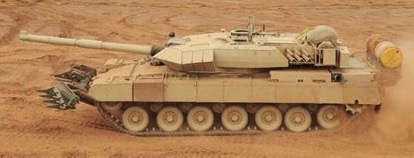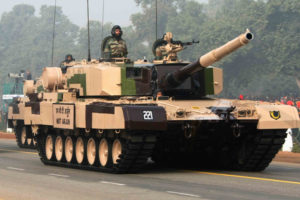A few bits of tank-related news have been caught in the hopper, so let’s do a quick roundup:
The US Army’s main battle tank, the M1 Abrams, is about to receive a new multipurpose super tank round that can breach concrete walls, pulverize obstacles, and destroy bunkers, according to Forbes.
The Advanced Multi-Purpose, or AMP, is specially designed for the M1 Abrams to replace the rapidly aging inventory of tank munitions.
The new round is long overdue as tank crews on the modern battlefields in the Middle East have been confronted by new evolving threats.
Unlike the M829 depleted uranium round, which can punch through almost anything – it tends to have difficulties blowing up vehicles or houses, as it just zips right through those types of targets. The new AMP can destroy everything the M829 cannot.
Well, duh. The M829 is an APFSDS round, a kinetic kill anti-tank munition that does its damage via spawling and hydrodynamic shock effects. It’s not designed to breach buildings. For that you’d probably fire a M830A1 HEAT round. But that too is designed for maximum effect vs. armor rather than concrete.
“The AMP adds an important new capability. The existing canister round is only for short-range use with a maximum reach of about 500 meters. This makes it useless for dealing with one of the biggest threats to tanks, infantry equipped with anti-tank guided missiles like the Russian-made AT-14 Kornet, used in Iraq, Syria, and Yemen. When used in airburst mode, the AMP can target groups of personnel at ranges of up to 2,000 meters: even if it does not disable a missile team, the round is likely to distract them enough so that they are not able to keep a missile on course.”
Another important new capability is breaching walls. Currently, making a breach an infantry assault requires engineers to get next to the wall and emplace explosives. Three rounds of AMP will create a thirty-by-fifty-inch hole clean through a double-thickness reinforced concrete wall, big enough for troops to advance through. This includes cutting through the steel reinforcement bars, and breaching can be carried out from several hundred meters away,” said Forbes.
Forbes described the new round has “three different fusing options” for blowing up different targets.
“With Point Detonation, the round explodes on contact with the target — this mode will make it effective against targets like light armored vehicles. Set to Point Detonation-Delay, the round does not explode immediately on contact – this is the mode used against obstacles and bunkers, as it gives enough time to penetrate deeply into concrete or other material before exploding. In the Airburst mode, the round explodes at a pre-set height above the ground, spraying the area below with tungsten shrapnel – this is the antipersonnel mode,” said Forbes.
Here’s video of it in action:
On Jan. 30, China North Industries Group Corporation announced on state-owned television that Type 15 (also known as ZTQ-15) lightweight battle tank entered service with the Xinjiang Military Command of the People’s Liberation Army Ground Force (PLAGF).
China Central Television (CCTV) said an undisclosed number of Type 15s were delivered to a PLAGF regiment in Xinjiang. CCTV broadcaster said it was “the first lightweight tank to join the military command.”
The Xinjiang mention is interesting. I’ve long wondered if China’s brutal treatment of the Uighers would provoke an indigenous revolt. Maybe it already has?
The broadcaster said the Type 15s are outfitted with special oxygen equipment to allow the tanks to operate at high altitudes.
Janes said no confirmation on how many Type 15s were deployed, but it appears these new tanks will significantly increase PLAGF’s combat capabilities in the region.
The Type 15 was announced in 2018, but now they’re making it out into the field. It evidently has a 105mm rifled main gun.
The Army recently started its light tank prototype assessment, according to Jane’s. Part of the vehicle assessment phase will rely on solider input, and tanker crews will be able to put the MPF prototypes through their paces themselves, as well as contribute feedback in order to improve platform characteristics.
The Army is specific in what it wants the Mobile Protected Firepower vehicle to accomplish, specifying that the MPF must be able to “neutralize enemy prepared positions and bunkers and defeat heavy machine guns and armored vehicle threats during offensive operations or when conducting defensive operations against attacking enemies.”
Though the Army’s light tank project would be a radical departure from steadily increasing main battle tank weight, it would not be the first time Army leadership opted for a smaller, more mobile armored platform. In the mid-1960s and early 1970s, the United States developed the M551 Sheridan light tank, a dedicated armored reconnaissance/airborne assault vehicle.
Snip.
Two companies have submitted prototypes to the Army: BAE Systems, and General Dynamics Land Systems division.
BAE Systems has the advantage of drawing upon and updating their M8 Armored Gun System, a mid-1990s project that attempted to serve as an air-mobile light tank for American airborne troops. BAE’s bid appears to carry over some features of the M8 project, including a 105mm main gun, possibly with an autoloader, and with more modern armor features that the company claims offers equal protection as their “highly survivable” Armored Multi-Purpose Vehicle.
On the other hand, General Dynamics benefits from extensive tank design and manufacture experience, as the company builds the venerable M1 Abrams main battle tank. Their bid is based on GD’s AJAX armored fighting vehicle and features a modified version of the Abrams turret. This could indicate a desire to retain the Abrams’ larger 120mm main gun, despite housing it on the smaller MPF platform. Lastly, GD claims that their light tank would benefit from a high-performance diesel engine that would afford a high power to weight ratio.
The return of the light tank is an interesting development, since most nations have opted for infantry fighting vehicles (remember, Bradleys were able to take out T-72s in Desert Storm) or wheeled combat vehicles like the Stryker or Mowag Piranha for similar roles. But if you were looking for a good use case for light tanks, a guerilla war in Xinjiang or the Chinese-Indian border probably fits the bill.
Prime Minister Narendra Modi Sunday handed over the indigenously developed Arjun Main Battle Tank (MK-1A) to the Indian Army at a ceremony in Chennai. The army will get 118 units of the Main Battle Tank, indigenously designed, developed and manufactured by CVRDE and DRDO along with 15 academic institutions, eight labs and several MSMEs.
The Arjun Main Battle Tank project was initiated by DRDO in 1972 with the Combat Vehicles Research and Development Establishment (CVRDE) as its lead laboratory. The objective was to create a “state-of-the-art tank with superior fire power, high mobility, and excellent protection”. During the development, the CVRDE achieved breakthroughs in the engine, transmission, hydropneumatic suspension, hull and turret as well as the gun control system. Mass production began in 1996 at the Indian Ordnance Factory’s production facility in Avadi, Tamil Nadu.
The Arjun tanks stand out for their ‘Fin Stabilised Armour Piercing Discarding Sabot (FSAPDS)’ ammunition and 120-mm calibre rifled gun. It also has a computer-controlled integrated fire control system with stabilised sighting that works in all lighting conditions. The secondary weapons include a co-axial 7.62-mm machine gun for anti-personnel and a 12.7-mm machine gun for anti-aircraft and ground targets.
The MK-1A is about ten tons heavier than its predecessor, which probably indicates upgraded Kanchan composite armor, the exact thickness of which seems to be classified. It also appears to have some new sloped armor panels (possibly reactive) to the front of the turret:

Which is probably a good thing, since its predecessor had a really boxy turret:
